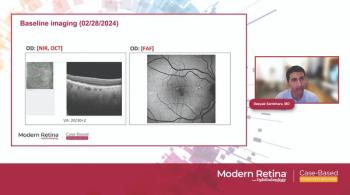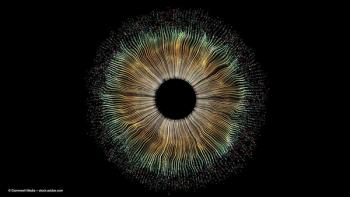
Outer retinal layer thickness predicts visual acuity in diabetic macular oedema
Diabetes mellitus is a common health problem in developed countries, with diabetic macular oedema (DMO) being a major cause of visual loss. A variety of treatment modalities for DMO are available including laser, steroid and intravitreal anti-vascular endothelial growth factor (anti-VEGF) agents.
Introduction
Diabetes mellitus is a common health problem in developed countries, with diabetic macular oedema (DMO) being a major cause of visual loss.1 A variety of treatment modalities for DMO are available including laser, steroid and intravitreal anti-vascular endothelial growth factor (anti-VEGF) agents.2-6
Evaluating DMO with OCT scans
Over the past 10 years, optical coherence tomography (OCT) scans have been used to provide a quantitative assessment of DMO and to evaluate the efficacy of treatment as it provides a fast, objective and non-invasive way of detecting structural changes.7 The correlation between visual acuity and OCT-measured variables, however, has not yet been well established. Some reports of OCT-measured macular changes show a correlation with vision, but several studies have had conflicting results.7-11
Retinal microstructures can now be seen, as advances in OCT technologies have led to faster scanning and higher axial resolution. Therefore, we can study morphological changes in the outer retinal hyper-reflective bands, specifically the inner segment/outer segment (IS/OS) junction, and measure the length of the photoreceptor outer segment (PROS).
Both IS/OS integrity and PROS length have been reported to be indicators of visual acuity in DMO and other diseases. 12-13
Forooghian et al measured the distance between the IS/OS junction and RPE layer to approximate the PROS length and showed that vision correlated better with PROS length than with macular thickness in DMO.13
The inner segment of photoreceptor, however, is also important for vision because it contains mitochondria and provides energy for the phototransduction process.
A study was therefore designed to measure the distance between the retinal pigment epithelium (RPE) and ELM to approximate the length of inner and outer segments of photoreceptors, and to determine its correlation with visual acuity in patients with DMO.14
Methods
Adults with evidence of DMO determined on OCT scan or slit lamp biomicroscopy, who attended the University of Hong Kong Eye Clinic during a 3-month period were recruited for the study.14
Spectralis spectral-domain OCT was used to assess the foveal structures and Heidelberg Explorer was used to analyse data captured. The ELM, RPE and internal limiting membrane (ILM) were manually set. The brightest point of ELM and RPE at the foveal centre was used as the reference point for measurement of thickness. The central foveal point (CFP) thickness was measured as the distance between the ILM and RPE, and the outer retinal layer (ORL) thickness was measured as the distance between ELM and RPE at the foveal centre. Patients were excluded if there was ELM disruption or RPE segmentation.
Results14
Of the 78 patients recruited, the mean age of patients was 58.1 years and the mean visual acuity was 20/40. The mean CFP thickness was 398 μm and the mean ORL thickness was 115.7 μm.
The correlation coefficient and square of the correlation coefficient between the CFP thickness and Snellen visual acuity were 0.34 and 0.12 respectively (P<0.001). The correlation coefficient and square of the correlation coefficient between ORL thickness and Snellen visual acuity was −0.65 and 0.42 respectively (P<0.001).
Correlation between central retinal thickness and vision
The correlations between central retinal thickness and visual acuity have been reported in many studies but the results varied and different measurements were used in different studies.7-11 In this study14, ORL thickness was defined as the distance between ELM and RPE, which is the sum of the inner and outer segments of photoreceptors. Both segments are important for vision: the inner segment contains mitochondria and provides energy, whereas the outer segment contains discs with opsin that absorb photons for phototransduction. Decrease in ORL thickness therefore reflected damage to photoreceptors and decrease in visual function.
ORL thickness should be a better prognostic measurement of vision than total retinal thickness because it was not affected by the amount of cystoid oedema in the outer plexiform layer and subretinal fluid. When the cystoid oedema and subretinal fluid resolve after treatment, the total retinal thickness would return to normal but damage to photoreceptors remains, leading to decrease in ORL thickness. This study revealed a high correlation between ORL thickness and visual acuity i.e. thicker ORL was associated with better vision. 14 This correlation was stronger than that between total retinal thickness at foveal centre and visual acuity. 14
Limitations and further research
This study14 was limited to patients who had DMO without ELM disruption or RPE segmentation on OCT scans. The result is therefore not applicable to patients whose DMO is severe and associated with ELM or RPE damage. It should be noted that most studies in the literature used central subfield thickness to assess foveal thickness whereas this study used CFP thickness instead. Therefore, direct comparison of this study result with that of other studies is difficult. In addition, this study did not assess parameters contributing to vision other than photoreceptor health such as perfusion status and amount of macular ischaemia.
Conclusion
In conclusion, ORL thickness appeared to have a better correlation with vision than CFP thickness in DMO. Further studies are warranted to investigate the use of ORL thickness as a prognostic factor of vision in DMO patients.
References
1. Kempen JH, O'Colmain BJ, Leske MC, Haffner SM, Klein R, Moss SE, Taylor HR, Hamman RF; Eye Diseases Prevalence Research Group. The prevalence of diabetic retinopathy among adults in the United States. Arch Ophthalmol. 2004;122:552-63.
2. Early Treatment Diabetic Retinopathy Study Research Group. Focal photocoagulation treatment of diabetic macular edema. Relationship of treatment effect to fluorescein angiographic and other retinal characteristics at baseline: ETDRS report no. 19. Arch Ophthalmol. 1995;113:1144-55.
3. Diabetic Retinopathy Clinical Research Network (DRCR.net), Beck RW, Edwards AR, Aiello LP, Bressler NM, Ferris F, Glassman AR, Hartnett E, Ip MS, Kim JE, Kollman C. Three-year follow-up of a randomized trial comparing focal/grid photocoagulation and intravitreal triamcinolone for diabetic macular edema. Arch Ophthalmol. 2009;127:245-51.
4. Nguyen QD, Brown DM, Marcus DM, Boyer DS, Patel S, Feiner L, Gibson A, Sy J, Rundle AC, Hopkins JJ, Rubio RG, Ehrlich JS; RISE and RIDE Research Group. Ranibizumab for diabetic macular edema: results from 2 phase III randomized trials: RISE and RIDE. Ophthalmology. 2012;119:789-801.
5. Elman MJ, Bressler NM, Qin H, Beck RW, Ferris FL 3rd, Friedman SM, Glassman AR, Scott IU, Stockdale CR, Sun JK; Diabetic Retinopathy Clinical Research Network. Expanded 2-year follow-up of ranibizumab plus prompt or deferred laser or triamcinolone plus prompt laser for diabetic macular edema. Ophthalmology. 2011;118:609-14.
6. Brown DM, Schmidt-Erfurth U, Do DV, Holz FG, Boyer DS, Midena E, Heier JS, Terasaki H, Kaiser PK, Marcus DM, Nguyen QD, Jaffe GJ, Slakter JS, Simader C, Soo Y, Schmelter T, Yancopoulos GD, Stahl N, Vitti R, Berliner AJ, Zeitz O, Metzig C, Korobelnik JF. Intravitreal Aflibercept for Diabetic Macular Edema: 100-Week Results From the VISTA and VIVID Studies. Ophthalmology. 2015;122:2044-52.
7. Baskin DE. Optical coherence tomography in diabetic macular edema. Curr Opin Ophthalmol. 2010;21:172-7.
8. Kim BY, Smith SD, Kaiser PK. Optical coherence tomographic patterns of diabetic macular edema. Am J Ophthalmol. 2006;142:405-12.
9. Diabetic Retinopathy Clinical Research Network, Browning DJ, Glassman AR, Aiello LP, Beck RW, Brown DM, Fong DS, Bressler NM, Danis RP, Kinyoun JL, Nguyen QD, Bhavsar AR, Gottlieb J, Pieramici DJ, Rauser ME, Apte RS, Lim JI, Miskala PH. Relationship between optical coherence tomography-measured central retinal thickness and visual acuity in diabetic macular edema. Ophthalmology. 2007;114:525-36.
10. Koleva-Georgieva D, Sivkova N. Assessment of serous macular detachment in eyes with diabetic macular edema by use of spectral-domain optical coherence tomography. Graefes Arch Clin Exp Ophthalmol. 2009;247:1461-9.
11. Murakami T, Yoshimura N. Structural changes in individual retinal layers in diabetic macular edema. J Diabetes Res. 2013;2013:920713.
12. Wong IY, Iu LP, Koizumi H, Lai WW. The inner segment/outer segment junction: what have we learnt so far? Curr Opin Ophthalmol. 2012;23:210-8.
13. Forooghian F, Stetson PF, Meyer SA, Chew EY, Wong WT, Cukras C, Meyerle CB, Ferris FL 3rd. Relationship between photoreceptor outer segment length and visual acuity in diabetic macular edema. Retina. 2010;30:63-70.
14. Wong RL, Lee JW, Yau GS, Wong IY. Relationship between Outer Retinal Layers Thickness and Visual Acuity in Diabetic Macular Edema. Biomed Res Int. 2015;2015:981471.
Newsletter
Keep your retina practice on the forefront—subscribe for expert analysis and emerging trends in retinal disease management.










































